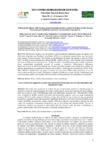Please use this identifier to cite or link to this item:
http://www.alice.cnptia.embrapa.br/alice/handle/doc/1007845| Title: | Utilização de análises multivariadas como ferramenta auxiliar a seleção de fêmeas bovinas da raça Brahman para habilidade maternal e características reprodutivas. |
| Authors: | ASSIS, A. S. de  MAGNABOSCO, C. de U.   LOPES, F. B.   SOUZA, F. M.   MOREIRA, L. da C.   NARCISO, M. G.   NAKAGAWA, A. F.   COSTA, M. F. O. e   |
| Affiliation: | Alliny Souza de Assis; CLAUDIO DE ULHOA MAGNABOSCO, CPAC; Fernando Brito Lopes; Flávia Martins de Souza; Ligia da Cunha Moreira; MARCELO GONCALVES NARCISO, CNPAF; Ângelo F. Nakagawa; MARCOS FERNANDO OLIVEIRA E COSTA, CNPAF. |
| Date Issued: | 2014 |
| Citation: | In: CONGRESSO BRASILEIRO DE ZOOTECNIA, 24., 2014, Vitória. Anais... Vitória: UFES, 2014. |
| Pages: | 3 p. |
| Description: | Objetivou-se avaliar o uso da estatística multivariada para identificar grupos de animais com Diferenças Esperadas nas Progênies semelhantes (DEPs) e as principais características que descrevem estes animais. Foram utilizadas 7.835 fêmeas da raça Brahman da marca OB, durante os anos de 1996 a 2012. As DEPs foram estimadas pelo método REML. Análises de uni e multivariadas foram realizadas por meio da DEP maternal para peso aos 120 dias de idade, e das DEPs diretas para a idade ao primeiro parto, produtividade acumulada, período de gestação e stayability. Observaram-se diferenças significativas entre as DEPS dos animais dos Clusters (p<0,001) gerados pelo método de k-médias. As análises identificaram e agruparam os animais com melhores valorespara as características STAY, PAC, IPP e MP120 e identificaram um grupo de animais que apresentou DEPs menos favoráveis. O uso da análise multivariada pode resumir informações e ajudar os produtores a tomar decisão, contribuindo para o melhoramento genético no rebanho, além de auxiliar no direcionamento de acasalamentos otimizados. Abstract: This study was carried out to evaluate the use of multivariate statistics to identify groups of animals with similar expected progeny differences (EPD) and the main traits that describe these animals. Data were collected from 7,835 Brahman cattle from OB Ranch, between years 1996 and 2012. EPDs were estimated by REML method. Univariate and multivariate analyzes were run using standardized maternal EPDs for body weight at 120 days of age, direct EPDs for age at first calving, accumulated productivity, gestation length and stayability. Significant differences were observed between EPDs of the clusters (p<0.001) generated by k-means method. With these analyses was possible to identify the best cluster for stayability, accumulated productivity, age at first calving and maternal ability. The use of multivariate analysis can summarize information and help farmers make decisions, contributing to genetic improvement in the herd, and assist in targeting breeding objective. |
| Thesagro: | Reprodução animal |
| NAL Thesaurus: | Animal reproduction Brazil discriminant analysis |
| Keywords: | Análises discriminantes Cluster Brasil |
| Type of Material: | Artigo em anais e proceedings |
| Access: | openAccess |
| Appears in Collections: | Artigo em anais de congresso (CPAC)  |










